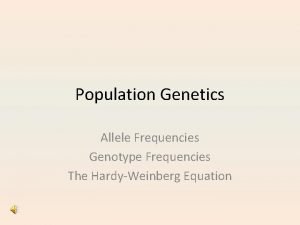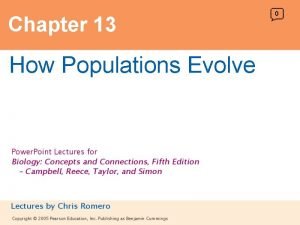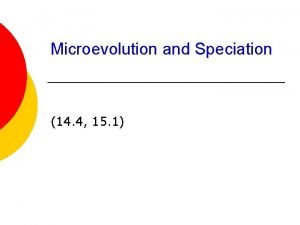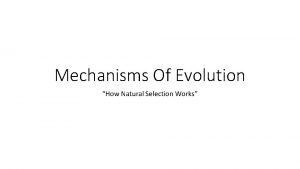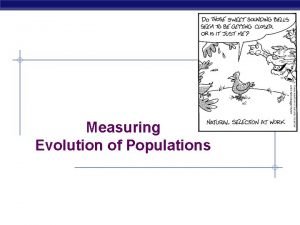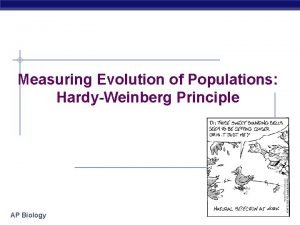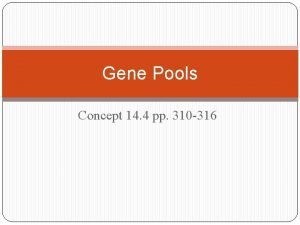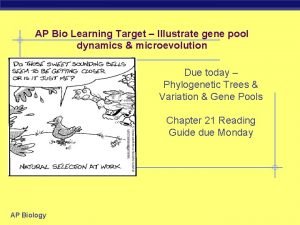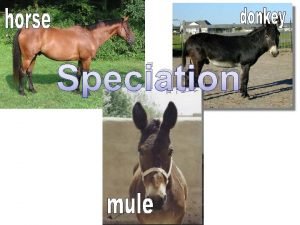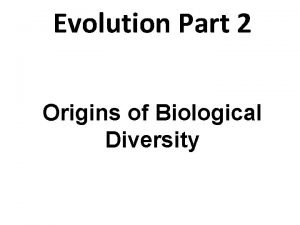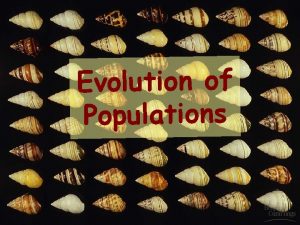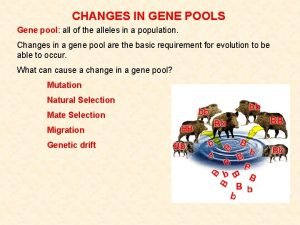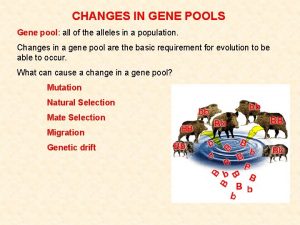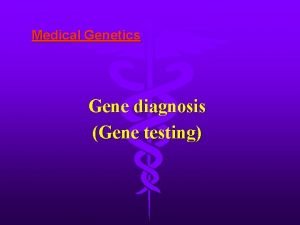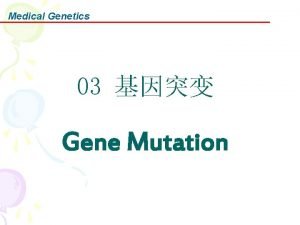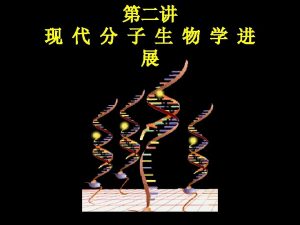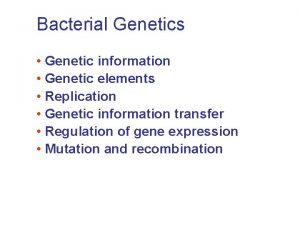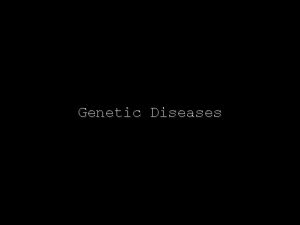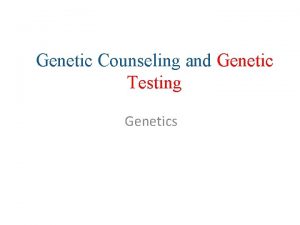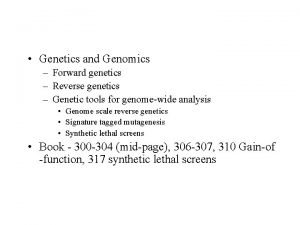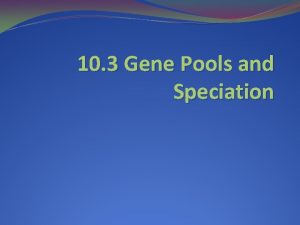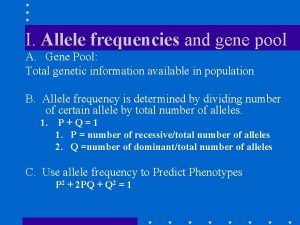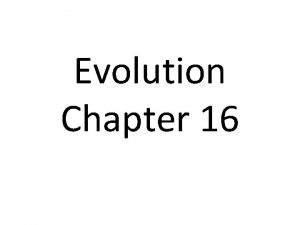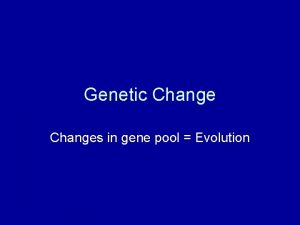Genetics I Genetic Diversity Gene Pool All the




















- Slides: 20

Genetics

I. Genetic Diversity • Gene Pool - All the different genes found in a population (same species) • Variation is good for survival of a population!

II. Causes of Variation 1. Combinations of different parents 2. Independent Assortment: only one of the two genes from a parent goes into each sex cell 3. Cross-over during meiosis 4. Mutations

III. Alleles • Allele = Version of a gene Ex: red or brown hair • Expressed trait = the allele you “show” • Humans have 2 alleles (one from mom, one from dad) for each trait Example: Gene = flower color Alleles = purple or white

• Dominant Alleles – Allele that “masks” recessive alleles; always shows – Represented with a capital letter (A)

• Recessive Alleles – Allele that is “masked” by dominant alleles – Trait will only show if alleles from both parents are recessive – Represented with lower case letter (a)

• Gregor Mendel - Determined the Principle of Dominance: some alleles are dominant, some are recessive

IV. Predicting Genetics • Punnett Squares – used to determine probability of offspring traits • Each parent gives only one of their two alleles (genes) for a trait – but which one is RANDOM!

• Vocabulary: A. Genotype: the alleles (genes) a person has for a trait, represented by letters Ex: AA 1. Homozygous: two of the same alleles (AA, aa) 2. Heterozygous: two different alleles (Aa), also called a hybrid or carrier of a trait

B. Phenotype: the physical trait that is shown Ex: red hair

V. Punnett Squares • Each square shows a possible combination of the two parents’ genes Possible alleles from DAD Possible alleles from MOM


Bring top letter down, side letters over. What is the probability (%) that a child will be aa? What is the probability that a child will be Aa?

Practice: 1. Draw a Punnett Square 2. Cross a homozygous dominant father with a homozygous recessive mother 3. What is the probability (%) of a homozygous recessive child?

• Ratios: Used to say what the probability of one outcome is compared with another Ex: #tall vs. #short #tall : #short A. Genotypic Ratios 1. What are the possible genotypes? AA, Aa, aa 2. How many of each? 1 AA, 2 Aa, 1 aa 1: 2: 1 A = tall , a = short (25% chance AA, 50% chance Aa, 25% chance aa)

B. Phenotypic Ratios 1. What are the possible phenotypes? Tall, short 2. How many of each? 3 tall, 1 short therefore 3: 1 (75% chance tall, 25% chance short) A = tall , a = short

You try! 1. What is the probability (%) of these parents having a child that is AA? Aa? aa? 2. What is the probability of these parents having a child that is red? blue?

• Genotypic ratio Genotypes: Aa # of each: 4 Ratio: 4: 0 or 1: 0 • Phenotypic ratio Phenotypes: Red # of each: 4 Ratio: 1: 0

You try! • Genotypic ratio Genotypes: # of each: Ratio: • Phenotypic ratio Phenotypes: # of each: Ratio: T = dark green t = light green

Probability question. Purple ears (E) is dominant over green ears (e). 1. Cross a homozygous dominant father with a heterozygous mother. 2. What is the probability (%) they will have a child that is heterozygous for this trait? 3. What color will that heterozygous child have? **Start by making a Geno-Pheno KEY: geno’s pheno’s EE, Ee Purple ears ee Green ears
 Genetic diversity and biodiversity
Genetic diversity and biodiversity Genetic diversity vs species diversity
Genetic diversity vs species diversity Chapter 12 section 1 dna the genetic material
Chapter 12 section 1 dna the genetic material Genetic drift vs genetic flow
Genetic drift vs genetic flow Genetic programming vs genetic algorithm
Genetic programming vs genetic algorithm Genetic programming vs genetic algorithm
Genetic programming vs genetic algorithm What is the difference between genetic drift and gene flow
What is the difference between genetic drift and gene flow Gene flow vs genetic drift
Gene flow vs genetic drift Gene frequency
Gene frequency Genetic pool
Genetic pool Genetic drift vs gene flow vs natural selection
Genetic drift vs gene flow vs natural selection Mechanism of evolution
Mechanism of evolution What is gene flow and genetic drift
What is gene flow and genetic drift Genetic drift vs gene flow
Genetic drift vs gene flow Genetic effects on gene expression across human tissues
Genetic effects on gene expression across human tissues Gene pool definition biology
Gene pool definition biology Gene pool ap bio
Gene pool ap bio Behavioral isolation
Behavioral isolation Individuals don't evolve populations do
Individuals don't evolve populations do Gene pool
Gene pool Genetic diversity
Genetic diversity








